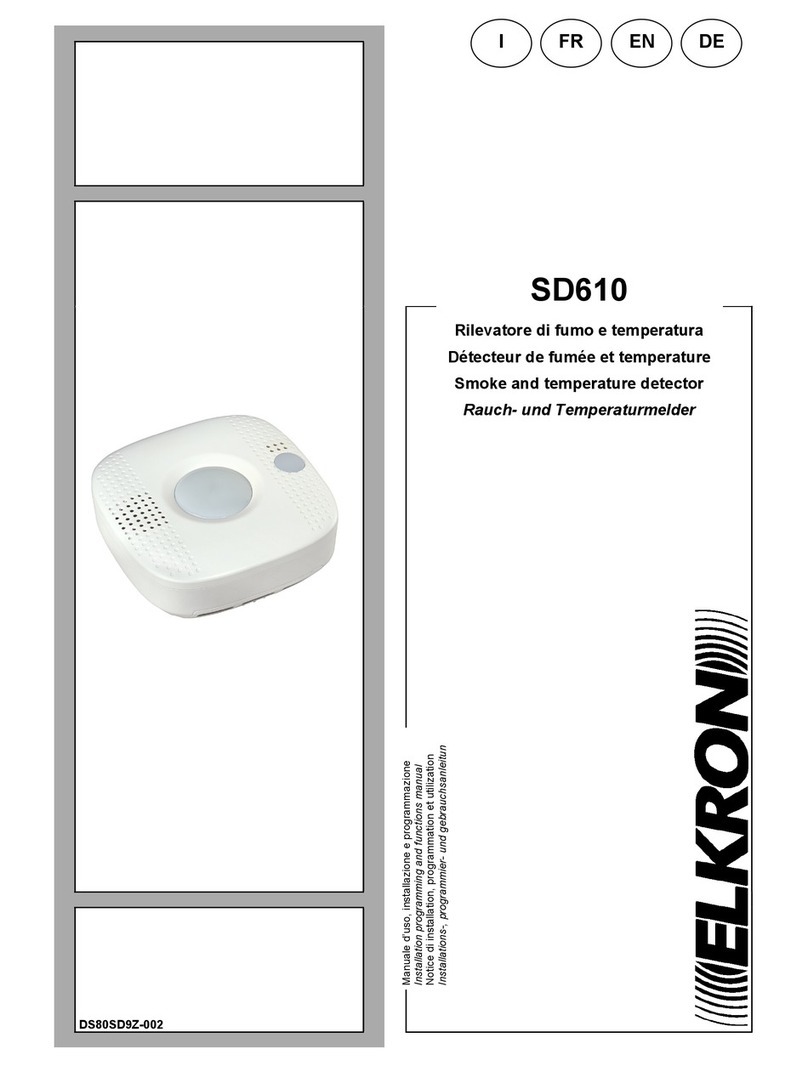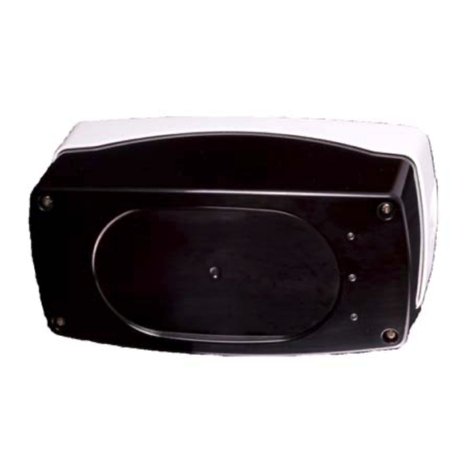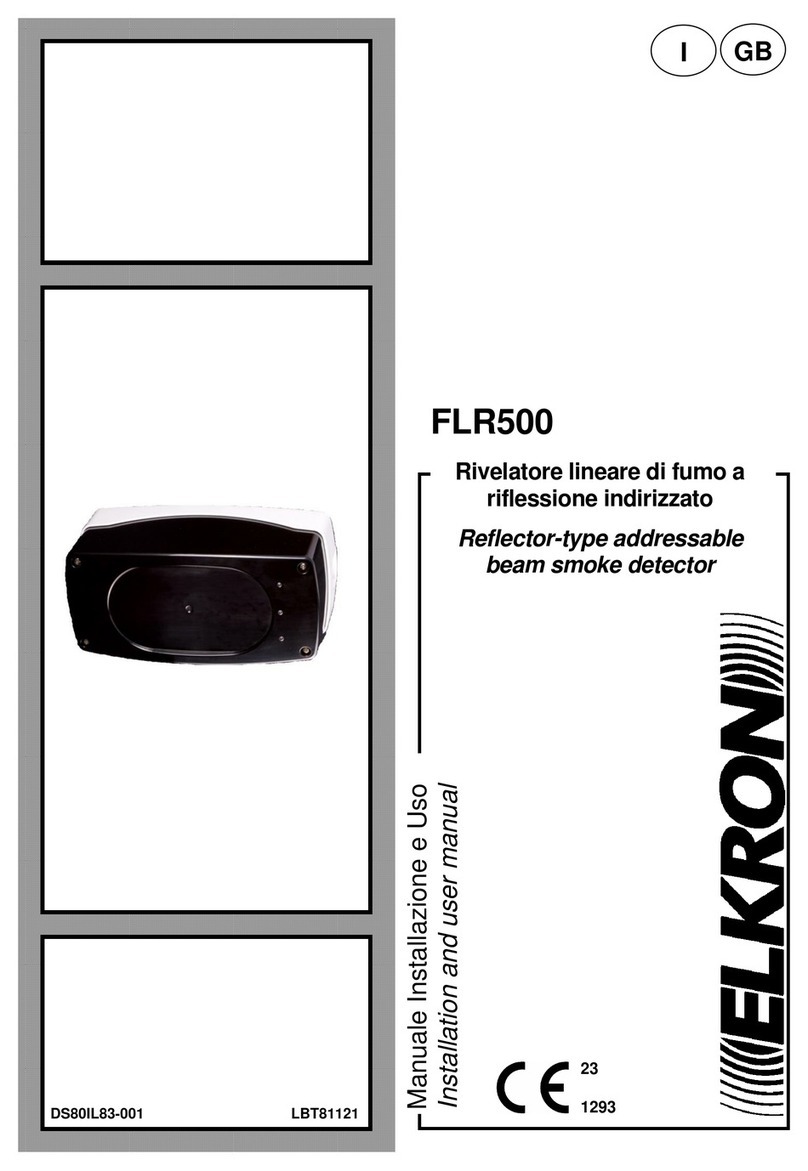
DS80SD8Z-002 3
arancione lampeggerà ogni 45 secondi insieme ad un bip di bassa intensità. Entrambi i LED, rosso e arancione, lampeggeranno
ogni 4 secondi quando la batteria sarà considerata scarica e quindi da sostituire prima che il dispositivo smetta di funzionare.
Durante la sostituzione delle batterie, dopo aver rimosso quelle esauste, premere l'interruttore tamper o Apprendimento/Test un
paio di volte per scaricare completamente il dispositivo prima di inserire le batterie nuove.
Test di funzionamento
Premendo il pulsante di Test, il rilevatore attiva un test per verificare il corretto funzionamento.
Se il sensore funziona regolarmente, il LED rosso lampeggerà brevemente a conferma che la comunicazione con l’unità
di controllo è andata a buon fine. Subito dopo il lampeggio vengono emessi tre toni, a conferma che anche
l’autodiagnosi del rilevatore ha dato esito positivo.
Se il buzzer non emette alcun suono, la Camera Ottica interna potrebbe essere sporca o fuori servizio.
Se, dopo aver premuto il pulsante di Test, il LED rosso lampeggia velocemente per 1 secondo, l’unità di controllo ha
correttamente ricevuto il segnale di test e ha inviato la conferma al dispositivo. Se non vi è conferma da parte dell’unità
di controllo, il LED rosso lampeggerà 3 volte.
Supervisione
Il sensore trasmette un segnale di supervisione (stato in vita) ogni 90/110 minuti.
Rilevazione allarmi
Un allarme per presenza di fumo viene generato quando la concentrazione di fumo all’interno della Camera Ottica ha superato
la soglia prefissata.
Il sensore controlla la presenza di fumo ogni 8 secondi.
In presenza di allarme, il dispositivo invia la segnalazione all’unità di controllo e attiva il proprio buzzer interno e il LED rosso che
inizierà a lampeggiare velocemente. La segnalazione acustica del rilevatore in caso di presenza fumo è facilmente riconoscibile
perché diversa dalla segnalazione acustica della centrale antifurto in caso di allarme furto.
Comportamento del dispositivo in caso di allarme
Il buzzer si attiva e il led inizia a lampeggiare:
- Premendo il pulsante Test dopo 1 minuto dalla rilevazione dell’allarme, il buzzer verrà silenziato per 9 minuti.
- Premendo il pulsante Test entro 1 minuto dalla rilevazione dell’allarme, il buzzer smetterà di suonare solo alla fine del
primo minuto.
- Durante i 9 minuti circa successivi alla pressione del tasto, il rilevatore continuerà a monitorare la presenza di fumo e il
LED rosso lampeggerà per tutto il tempo.
- Al termine dei 9 minuti circa, se la presenza di fumo sarà rimasta sotto la soglia, il LED smetterà di lampeggiare e
verranno emessi due bip per indicare l’uscita dallo stato di monitoraggio.
NOTA
Se la presenza di fumo dovesse scendere in modo significativo sotto la soglia di allarme o scomparire del
tutto entro un minuto dall’inizio del primo allarme, il rilevatore tornerà a riposo.
- Se invece, al termine dei 9 minuti e dopo l’emissione dei due bip, la presenza di fumo continua a rimanere sopra la
soglia, verrà attivato un nuovo allarme.
- Se la concentrazione di fumo aumenta durante i 9 minuti di silenzio e supera una seconda soglia, il dispositivo genera
immediatamente un nuovo allarme che non potrà essere silenziato.
- Se il pulsante Test non viene premuto in alcun caso, il buzzer e il led si disattiveranno quando la presenza di fumo
scenderà sotto la soglia o scomparirà del tutto.
Nota bene: gli allarmi possono essere tacitati solo localmente, non è possibile farlo da remoto
Ricalibrazione
Nel caso in cui le condizioni ambientali varino, è possibile eseguire una nuova calibrazione del sensore per stabilire le nuove
corrette soglie di allarme. Per fare ciò:
Premere e tenere premuto il pulsante Apprendimento/Test per 10 secondi e rilasciarlo quando il dispositivo emette 2
bip. Dopo 5 secondi verrà emesso un altro bip ed inizierà la fase di calibrazione. Il LED rosso lampeggerà ogni 2
secondi.
Il processo durerà da 1 a 9 minuti.
Una volta terminata la calibrazione, il dispositivo emetterà un suono bitonale e il LED rosso smetterà di lampeggiare
per indicare il ritorno allo stato normale.
Se la calibrazione fallisce il dispositivo emetterà un suono continuo e il LED arancione lampeggerà ogni secondo. In
questo caso rimuovere la batteria, premere il pulsante Apprendimento/Test due volte per scaricare il dispositivo e
reinserire la batteria per riavviarlo.
Avvertenze per l’installazione
Si raccomanda di installare il sensore al centro del soffitto. Non installare il sensore nei seguenti casi:
In cucina, dove i fumi di cottura potrebbero generare falsi allarmi.
Vicino a un ventilatore, a una lampada fluorescente o a un condizionatore d’aria, i cui movimenti d’aria potrebbero
generare falsi allarmi.
Vicino a travi del soffitto o al di sopra di pensili, perché una mancata circolazione d’aria può compromettere il
funzionamento.
Nel vertice di un profilo ad “A” del soffitto.
In zone soggette a repentini cambi di temperature causati, ad esempio, da termosifoni o condizionatori.





































